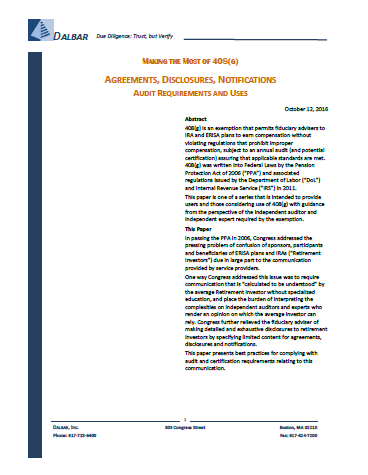408(g) is an exemption that permits fiduciary advisers to IRA and ERISA plans to earn compensation without violating regulations that prohibit improper compensation, subject to an annual audit (and potential certification) assuring that applicable standards are met. 408(g) was written into Federal Laws by the Pension Protection Act of 2006 (“PPA”) and associated regulations issued by the Department of Labor (“DoL”) and Internal Revenue Service (”IRS”) in 2011.
This paper is one of a series that is intended to provide users and those considering use of 408(g) with guidance from the perspective of the independent auditor and independent expert required by the exemption.
In passing the PPA in 2006, Congress addressed the pressing problem of confusion of sponsors, participants and beneficiaries of ERISA plans and IRAs (“Retirement Investors”) due in large part to the communication provided by service providers.
One way Congress addressed this issue was to require communication that is “calculated to be understood” by the average Retirement Investor without specialized education, and place the burden of interpreting the complexities on independent auditors and experts who render an opinion on which the average investor can rely. Congress further relieved the fiduciary adviser of making detailed and exhaustive disclosures to retirement investors by specifying limited content for agreements, disclosures and notifications.
This paper presents best practices for complying with audit and certification requirements relating to this communication.

Talk to us about how we can help you achieve your goals or customize an offering for your unique needs!
